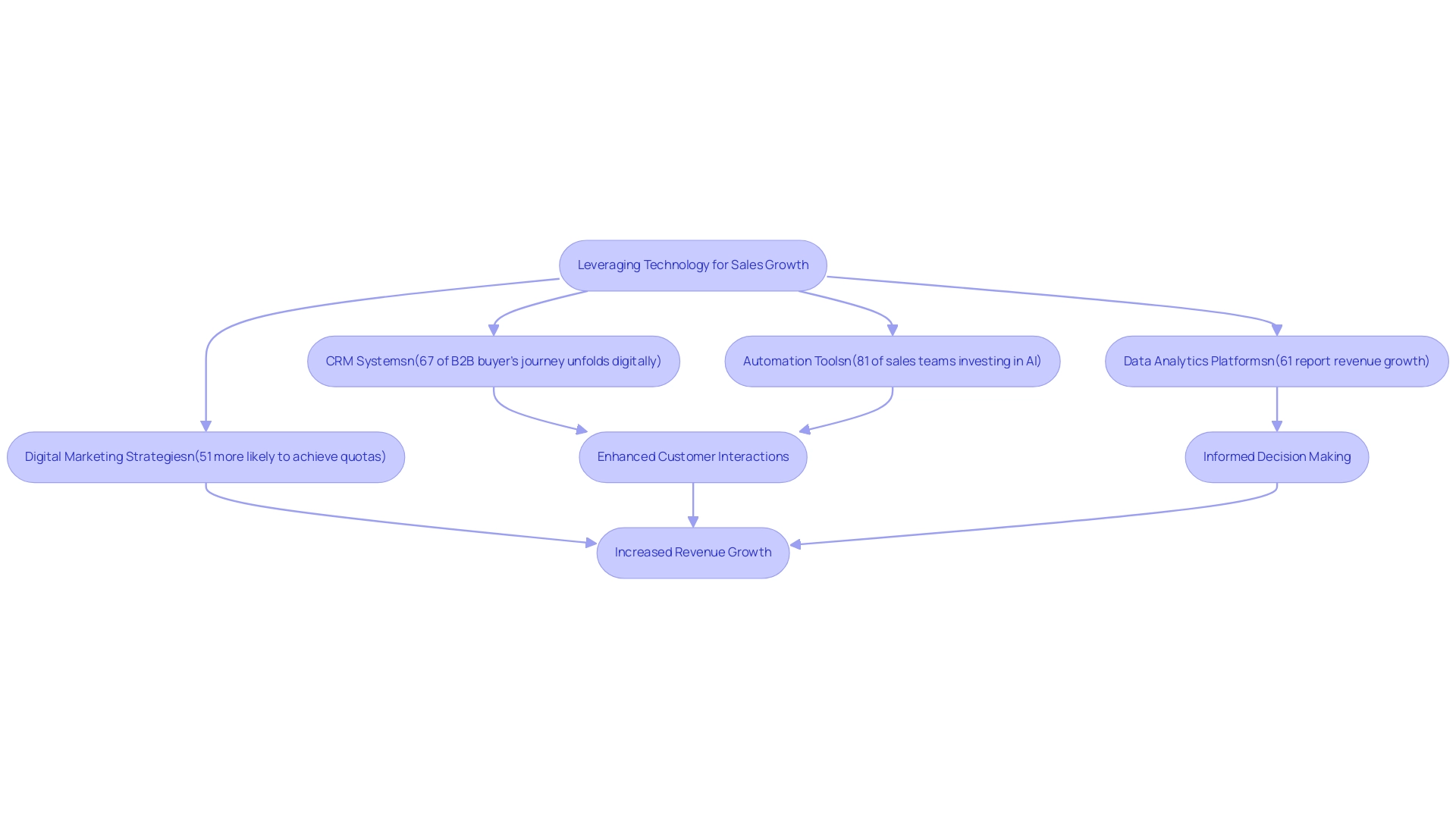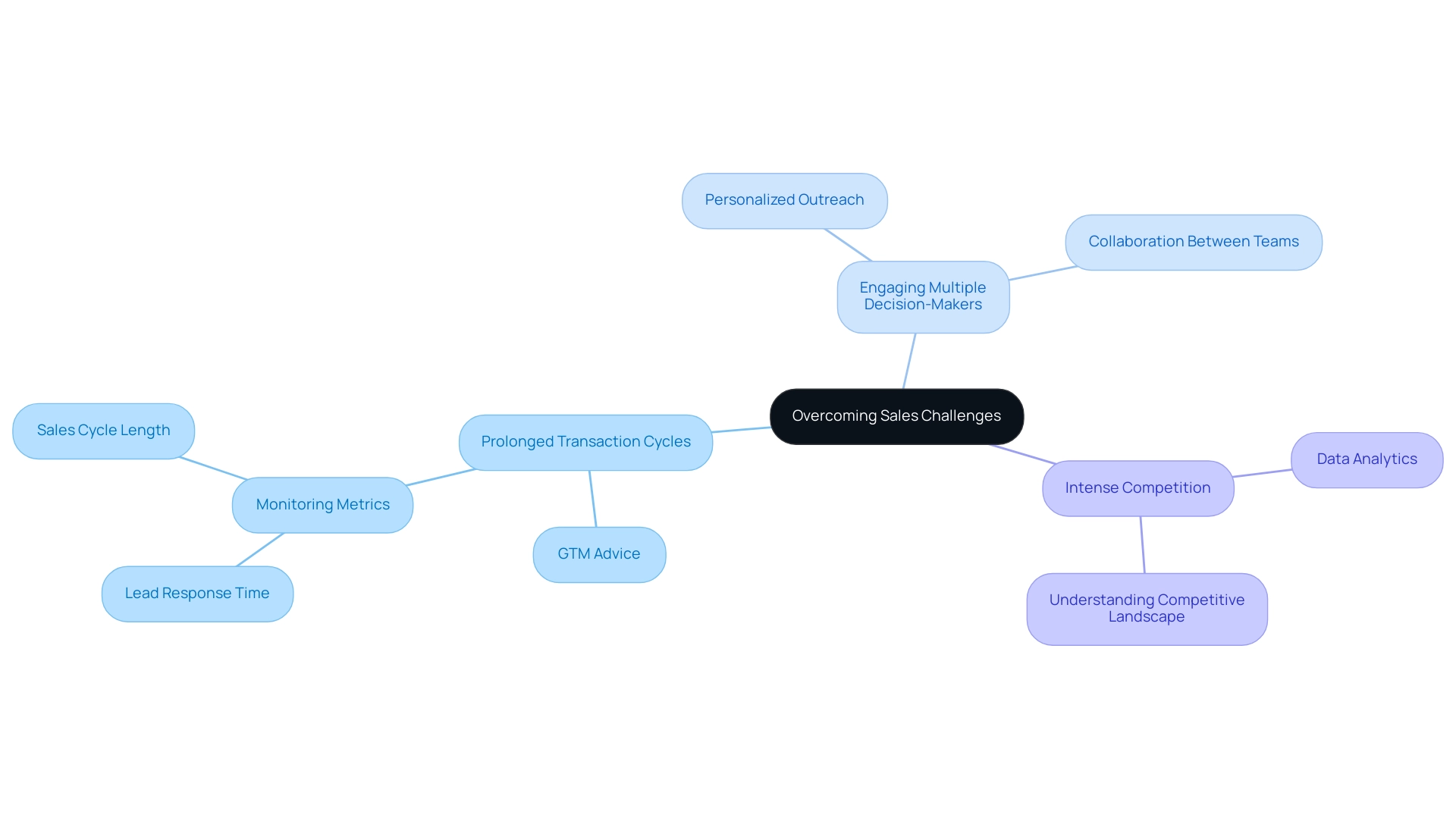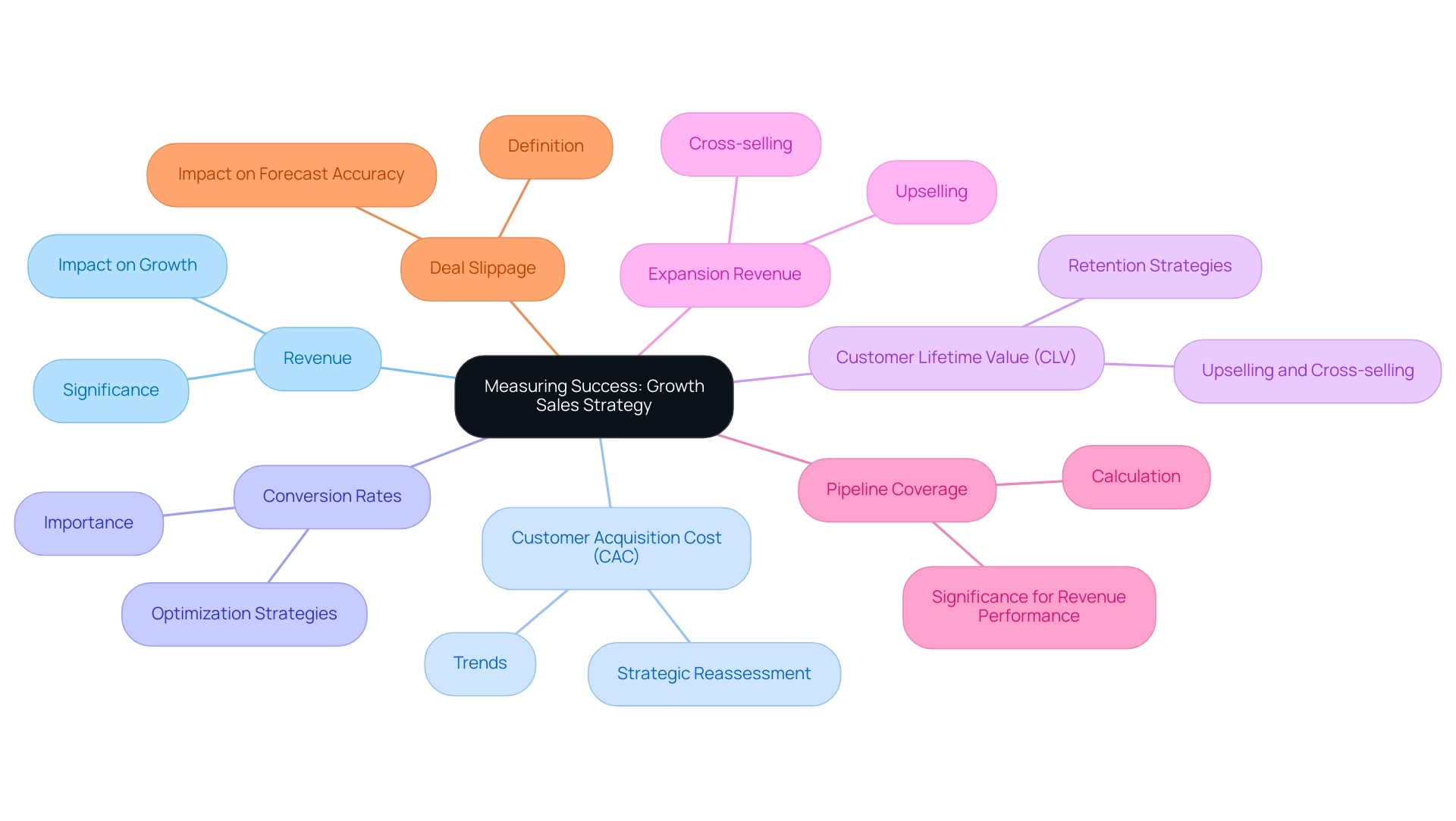
A growth sales strategy represents a comprehensive framework aimed at significantly enhancing a company's revenue through various methods, including:
This strategy aligns sales initiatives with broader organizational goals, ensuring a cohesive approach to growth. Successful implementation hinges on critical components such as:
Together, these elements foster sustainable growth and improve profitability in competitive markets. Companies that embrace this strategy position themselves to thrive, adapting to market dynamics and customer needs effectively.
In a rapidly evolving business landscape, the quest for sustainable growth has never been more critical. A well-defined growth sales strategy serves as a beacon for organizations aiming to increase revenue while aligning with broader business objectives. This multifaceted approach encompasses various tactics such as:
All designed to foster long-term success rather than just short-term gains. As companies embrace innovative frameworks and collaborative selling models, the integration of technology and data analytics becomes paramount, enabling them to navigate challenges and seize opportunities effectively. With the right strategy in place, businesses can not only thrive amidst fierce competition but also adapt to changing market dynamics, ensuring they remain at the forefront of their industries.
An expansion revenue plan serves as a comprehensive framework designed to assist companies in enhancing their income over a defined period. This plan encompasses various strategies, including market penetration, product development, and customer acquisition, all aimed at fostering sustainable growth. Unlike traditional approaches that often prioritize immediate revenue goals, a growth sales strategy aligns sales initiatives with broader organizational objectives, ensuring that companies not only meet short-term targets but also lay the groundwork for enduring success.
In 2025, the landscape of sales strategies is transforming, marked by a significant rise in collaborative selling models that integrate professionals across departments such as finance, operations, and marketing. As Eric Jacobson, Managing Director, observes, "Building out strategic offerings that connect Sales, Finance, Operations, Legal, and Accounting creates a truly connected cloud for clients." This trend underscores a growing recognition of the interconnectedness of various business functions in enhancing overall performance.
By fostering collaboration, organizations can craft a more cohesive strategy that boosts overall effectiveness.
The importance of a growth sales strategy cannot be overstated, particularly in today's competitive markets. It acts as a roadmap for scaling operations and improving profitability, allowing businesses to navigate challenges and seize opportunities. For instance, companies that embrace innovative marketing strategies, such as the customized frameworks offered by Magical Selling, and prioritize understanding client needs are better positioned to achieve lasting success.
Moreover, the incorporation of intent data, which assists sellers in identifying when prospects are actively researching products, further highlights the necessity of a strategic approach to commerce, enabling organizations to tailor their efforts more effectively.
Successful implementations of growth sales strategies in 2025 exemplify the effectiveness of customized frameworks. The 6D Selling framework, developed by Magical Selling, illustrates this approach by equipping clients with essential tools to excel in their business pursuits. This comprehensive methodology not only refines business processes but also drives measurable outcomes, empowering organizations to thrive in competitive landscapes.
Specifically, the 6D Selling framework has enabled clients to optimize their selling efforts, resulting in enhanced performance and sustainable growth even in challenging markets.
Additionally, Magical Selling's discovery workshops play a crucial role in identifying the 'kriptonites' within commercial teams, enabling organizations to tackle specific challenges and improve performance. The Seller Dimension feature further bolsters this by enhancing selling skills and motivation among team members, ensuring they are well-prepared to address their unique challenges effectively. Data indicates that companies employing a growth sales strategy experience significantly greater income increases compared to those relying on improvised methods.
For example, companies utilizing Magical Selling's Sales GPS and tailored frameworks have reported a 30% increase in deal closure rates within the first quarter of implementation. As organizations continue to adapt to market dynamics, the execution of effective revenue enhancement strategies, supported by innovative solutions such as Magical Selling's Sales GPS and customized frameworks, will be vital for maintaining a competitive edge and achieving enduring success.

A robust growth sales strategy encompasses several essential components that drive business success:
Integrating these elements into a growth sales strategy not only promotes sustainable development but also equips sales teams with the resources needed to succeed in a changing market environment. The emphasis on market analysis, in particular, cannot be overstated; it serves as the foundation for informed decision-making and strategic planning, ensuring that businesses remain competitive and responsive to market dynamics. Moreover, insights from the case study 'Revamping the Complete GTM and Sales Plan for a Regional Infra Provider' demonstrate how effective tactics can transform a company's method of competing with larger entities, ultimately generating significant market share.

Identifying and understanding your target audience is crucial for developing an effective growth strategy. Businesses can employ a variety of methods to gather insights about their audience, including:
By examining demographics, purchasing behaviors, and preferences, companies can segment their audience into distinct groups, allowing for more precise targeting.
This segmentation is not merely a theoretical exercise; it has tangible benefits. For instance, a technology firm might concentrate on small enterprises by providing tailored solutions that improve operational efficiency while also tackling the distinct challenges encountered by larger organizations. Such tailored marketing messages and sales approaches resonate more deeply with each segment, leading to improved engagement and conversion rates.
Expert opinions highlight the significance of behavioral segmentation, which categorizes consumers based on their interactions with products. This method enables organizations to refine their strategies further, ensuring that they meet the specific needs and pain points of each group effectively. As Bryan Philips from In Motion Marketing states, "We turn B2B marketing challenges into development opportunities," underscoring the importance of understanding the audience in navigating these challenges.
Incorporating consultative selling techniques, organizations can establish credibility by selling the problem first and then the solution, which is essential for effective engagement. This method not only improves the revenue process but also aligns with strategic account management plans that support a growth sales strategy focused on revenue growth and client retention.
Recent statistics reveal that while many B2B marketing teams recognize the importance of audience segmentation, only 19% have integrated AI into their daily processes to enhance this effort. This gap signifies a considerable chance for companies to utilize technology in comprehending their target audience more effectively and enhancing their sales approaches accordingly.
Case studies, such as the report titled "Map Out Your Approach for a Successful 2025," emphasize the importance of using statistical findings to inform marketing plans. By reflecting on current practices and adapting based on industry benchmarks, marketers can make informed decisions that secure the resources needed for success in the coming year. This report can assist marketers in improving their audience segmentation approaches, ensuring they are well-prepared for the challenges ahead.
Ultimately, comprehending the target audience not only influences marketing strategies but also significantly affects overall performance, fostering sustainable advancement.

In today's digital landscape, leveraging technology is crucial for crafting a growth sales strategy that propels revenue. Customer Relationship Management (CRM) systems, revenue automation software, and data analytics platforms empower teams to refine their processes and elevate customer interactions. For instance, CRM systems play a vital role in tracking customer engagements, managing leads, and analyzing revenue data, enabling teams to make informed, data-driven decisions.
Notably, 67% of the B2B buyer's journey unfolds digitally, highlighting the imperative for effective digital tools in marketing strategies. This is further underscored by the fact that 81% of teams are investing in AI, resulting in enhanced data quality and tailored customer interactions.
Automation tools also mitigate administrative burdens, allowing representatives to focus on relationship-building and closing deals. Companies that embrace these technologies experience substantial advantages; for example, organizations engaged in social selling are 51% more likely to achieve their quotas, with 61% reporting revenue growth as a direct result of their growth sales strategies. This trend underscores the essential role of technology in modern selling practices.
Moreover, traditional selling methods, such as door-to-door approaches, continue to coexist with digital advancements. Despite the increasing prevalence of digital tools, door-to-door marketing generates nearly $30 billion annually, illustrating the enduring effectiveness of human connection and persistence. Successful techniques involve high-volume prospecting combined with adaptable presentations, utilizing CRM tools for lead monitoring to enhance these traditional methods.
Magical Selling exemplifies this strategy by seamlessly integrating technology into its sales methodologies, such as the Heart of the Deal Method and the Problem Statement Method, which foster improved performance and client satisfaction. The effectiveness of CRM systems in driving revenue performance is evident in case studies where businesses have successfully implemented these tools, resulting in enhanced lead tracking and customer engagement. Additionally, the Seller Dimension framework emphasizes the importance of understanding customer needs and customizing approaches accordingly.
As revenue teams continue to harness technology and innovative frameworks from Magical Selling—including consultative techniques that build credibility and the Gym membership for ongoing training—the impact on their growth sales strategy becomes increasingly pronounced, establishing it as a critical component of any effective approach.

Training is crucial for enhancing revenue performance, particularly in the dynamic landscape of 2025. Effective training programs equip professionals with the skills necessary to navigate complex environments, understand customer needs, and articulate compelling value propositions. Organizations must prioritize ongoing training initiatives that integrate various methodologies, including:
For instance, Magical Selling's Discovery Workshops are meticulously designed to identify the 'kriptonites' within teams, focusing on motions, value articulation, and key differentiators. This targeted approach empowers sales teams to excel in their roles by addressing specific challenges and enhancing performance. Furthermore, Magical Selling's Sales Bond Academy exemplifies a commitment to nurturing a culture of learning and development within organizations.
Research indicates that 87% of learning and development professionals aim to cultivate a development mindset, which is essential for adapting to evolving market demands. Additionally, 87% of millennials consider professional development a key factor in job satisfaction, underscoring the importance of training in retaining talent and enhancing performance.
Moreover, statistics reveal that 56% of professionals in the industry utilize social media to identify new prospects, highlighting the necessity for training that encompasses digital tools alongside traditional methods. By integrating these elements, companies can significantly enhance effectiveness, boost employee engagement, and drive revenue growth. The 6D Selling framework, provided by Magical Selling, offers a comprehensive set of tools that specifically supports training initiatives, equipping organizations with methodologies that promote success in transactions.
Ongoing training not only improves individual performance but also contributes to the overall success of the team, making it a vital component of any effective strategy. Testimonials from clients who have participated in these workshops illustrate the tangible benefits and enhancements in their selling processes, further validating the effectiveness of the Magical Selling approach.

Sales teams often encounter a multitude of challenges that can significantly hinder their performance. Among the most common obstacles are:
To effectively navigate these hurdles, a robust growth sales strategy is imperative.
Implementing targeted approaches, such as the Go-To-Market (GTM) advice from Magical Selling, can yield substantial benefits. For instance, sharpening focus in key markets and deepening engagement with 50 target accounts can enhance revenue effectiveness. Utilizing data analytics enables organizations to pinpoint high-potential leads, allowing teams to concentrate their efforts where success is most likely.
Personalized outreach strategies can further improve engagement with decision-makers, fostering stronger relationships and increasing conversion likelihood.
Moreover, collaboration between marketing and distribution teams is essential in developing a cohesive strategy that thoroughly meets customer needs. This unified strategy not only streamlines communication but also ensures that both teams align with their objectives, ultimately leading to enhanced results. Establishing a new revenue cadence, including daily forecast reviews and continuous tracking, can effectively address resource allocation issues and provide real-time deal guidance.
Consistent follow-ups by representatives have demonstrated improved customer retention, illustrating to clients that their patronage is valued. This practice is vital to the overall marketing plan, as it strengthens relationships and promotes repeat business. By proactively addressing these challenges and employing strategic methodologies, organizations can significantly enhance their revenue effectiveness and drive a growth sales strategy.
In 2025, as the landscape evolves, it is projected that 60% of B2B seller work will be performed by generative AI, a substantial increase from under 5% in 2023. This shift underscores the necessity for commercial teams to adapt and integrate innovative technologies into their approaches. Monitoring key revenue process metrics—such as lead response time, cycle length, and conversion rates—will be essential for measuring performance and identifying areas for improvement.
By understanding and refining these metrics, teams can enhance their strategies and achieve greater success in an increasingly competitive market. Furthermore, sixty-five percent of employees assert that quality sales training positively influences their engagement, emphasizing the critical role of training in overcoming sales challenges.
To ensure continuous growth and momentum with less manual intervention, organizations should also prioritize streamlined planning. This strategy facilitates better resource allocation and strategic alignment across teams. Additionally, the expectation of swift, decisive action that leads to tangible results is paramount; as emphasized in our FAQs, "If it works, we can sell it."
Finally, understanding the competitive landscape is crucial. By utilizing Magical Selling's methods, clients can position themselves effectively against direct competitors, ensuring they not only survive but thrive in their respective markets.

Ongoing enhancement is vital for organizations aiming to maintain a competitive edge in the market. Regular evaluations of marketing strategies, processes, and performance metrics are crucial for identifying opportunities for improvement in our growth sales strategy. This iterative approach empowers businesses to adapt to evolving market conditions, shifting customer preferences, and the latest technological advancements.
For instance, consultative selling techniques, as outlined in Magical Selling's training modules, emphasize the necessity of establishing credibility and effectively addressing customer problems before presenting solutions. This method not only enhances selling abilities but also fosters trust and rapport with clients.
A recent case study titled 'Revamping the Complete GTM and Sales Plan for a Regional Infrastructure Provider' exemplifies how a comprehensive overhaul of selling functions can enable organizations to compete against larger cloud providers and capture market share. By redrawing the blueprint and implementing effective marketing strategies, the provider successfully generated a 5% market share, showcasing the transformative potential of well-executed business plans.
In 2025, the significance of adapting marketing methods is underscored by the fact that 77% of sales professionals now conduct virtual meetings, while 57% rely more on phone communications, and 51% utilize emails to engage with customers. These statistics highlight the necessity for commercial teams to evolve their methods in response to changing communication preferences.
Moreover, investing in training programs for personnel has proven to yield a remarkable 353% return on investment (ROI), reinforcing the importance of effective training in driving performance. By promoting a culture of ongoing enhancement, organizations can ensure that their growth sales strategy remains relevant and efficient, ultimately driving sustained growth. Regular evaluations of transactions and feedback meetings can provide invaluable insights into team performance and customer interactions, further improving the adaptability of commercial approaches in a dynamic market.
Additionally, understanding Customer Acquisition Cost (CAC) is crucial for assessing the efficiency of marketing methods, as it sheds light on the financial implications of selling processes. As HubSpot notes, 59% of marketing professionals assert that inbound marketing generates high-quality leads, compared to 16% who report that outbound marketing does. This emphasizes the importance of integrating efficient lead generation methods into the overall selling strategy.

Evaluating the success of a growth sales strategy requires a meticulous approach to monitoring key performance indicators (KPIs) that reflect both revenue performance and overall business growth. Key metrics include:
Understanding CAC trends, for instance, is essential; it provides insights into the effectiveness of marketing and promotional efforts.
In 2025, organizations are increasingly recognizing that a high CAC can signal the need for a strategic reassessment of their selling approaches, particularly through customized account segmentation methods tailored to the unique requirements of each account. It’s not about having a poor Account; it’s about employing an unsuitable sales strategy. Moreover, expansion revenue, which reflects increased revenue from existing clients through upselling or cross-selling, serves as a crucial indicator of a company's ability to cultivate and enhance its customer relationships.
This metric not only highlights the effectiveness of marketing strategies but also emphasizes the importance of customer retention in driving sustainable growth. By segmenting accounts based on the appropriate growth sales strategy rather than verticals or client size, businesses can double their productivity and significantly enhance their overall performance.
A key statistic to consider is pipeline coverage, calculated as total pipeline value divided by revenue quota. This quantitative measure supports discussions on revenue performance and assists organizations in evaluating whether they have sufficient opportunities to meet their targets. The case study on revamping the go-to-market (GTM) and revenue plan for a regional infrastructure provider illustrates how a strategic overhaul can empower companies to compete effectively against larger cloud providers, ultimately generating a 5% market share.
Additionally, a case study on deal slippage and forecast accuracy underscores the impact of KPIs on revenue performance. Deal slippage, defined as the postponement of deals beyond their expected close dates, can significantly hinder revenue execution and forecasting accuracy. By minimizing deal slippage, organizations can maintain high revenue productivity and ensure that their forecasts are reliable, leading to improved decision-making and resource allocation.
The significance of this outcome cannot be overstated, as it directly relates to the effectiveness of sales approaches.
Expert insights affirm that 'B2B Sales KPIs are a journey of discovery, planning, and refinement,' as stated by Dmytro Chervonyi, CMO at Forecastio. As companies navigate the complexities of the market, a robust measurement framework enables them to assess their progress and make data-driven decisions that support their growth sales strategy and drive continuous growth. By focusing on these critical KPIs and adapting strategies to meet evolving market demands, businesses can not only evaluate their current performance but also position themselves for future success.

The implementation of a growth sales strategy is essential for businesses aiming to achieve sustainable success in today's competitive landscape. By focusing on key components such as:
Organizations can effectively enhance their sales performance. The emphasis on leveraging technology through CRM systems and data analytics further supports these efforts, enabling teams to make informed decisions and streamline their operations.
Moreover, continuous training and development play a crucial role in equipping sales professionals with the skills needed to navigate complex environments and adapt to ever-changing market conditions. By fostering a culture of learning and improvement, organizations can ensure their sales teams remain effective and engaged, ultimately driving higher levels of productivity and revenue growth.
As the sales landscape continues to evolve, the importance of measuring success through key performance indicators cannot be overstated. By regularly assessing metrics such as:
Businesses can refine their strategies and ensure they are well-positioned to seize new opportunities.
In conclusion, embracing a comprehensive growth sales strategy not only lays the groundwork for immediate success but also fosters long-term resilience and adaptability. By integrating innovative approaches, leveraging technology, and prioritizing training, organizations can navigate the complexities of the market and thrive amidst fierce competition, securing their place at the forefront of their industries.
What is an expansion revenue plan?
An expansion revenue plan is a comprehensive framework designed to help companies enhance their income over a defined period through various strategies like market penetration, product development, and customer acquisition, aimed at fostering sustainable growth.
How does a growth sales strategy differ from traditional approaches?
Unlike traditional approaches that focus on immediate revenue goals, a growth sales strategy aligns sales initiatives with broader organizational objectives, ensuring that companies meet short-term targets while laying the groundwork for long-term success.
What trends are emerging in sales strategies for 2025?
In 2025, there is a significant rise in collaborative selling models that integrate professionals across departments such as finance, operations, and marketing, reflecting a growing recognition of the interconnectedness of various business functions to enhance overall performance.
Why is a growth sales strategy important in competitive markets?
A growth sales strategy serves as a roadmap for scaling operations and improving profitability, enabling businesses to navigate challenges and seize opportunities, especially in today's competitive environments.
What role does market analysis play in a growth sales strategy?
Market analysis is vital for understanding market trends, customer needs, and the competitive landscape, which helps businesses uncover growth opportunities and adapt to shifting consumer preferences.
How can companies identify their target audience effectively?
Clearly defining the target audience allows companies to customize their efforts to meet specific customer needs, boosting engagement and increasing conversion rates.
What is the significance of a compelling value proposition?
A compelling value proposition differentiates a business from its competitors by effectively communicating the unique benefits of its products or services, which is essential in a crowded marketplace.
What is involved in revenue process optimization?
Revenue process optimization involves streamlining processes to enhance efficiency and effectiveness, allowing teams to focus on high-value tasks that maximize productivity.
How can performance metrics improve a growth sales strategy?
Setting key performance indicators (KPIs) allows businesses to assess success and make data-informed modifications to their plans, enhancing marketing strategies based on real-time performance data.
What benefits have companies experienced from implementing growth sales strategies?
Companies employing a growth sales strategy have reported significantly greater income increases, with some utilizing tailored frameworks achieving a 30% increase in deal closure rates within the first quarter of implementation.